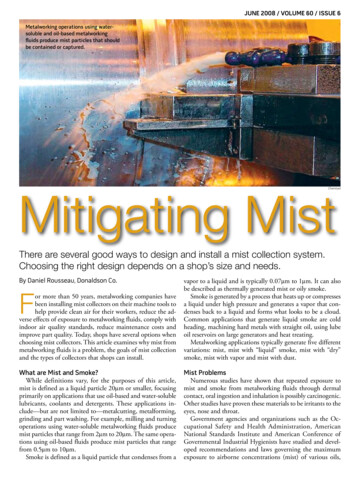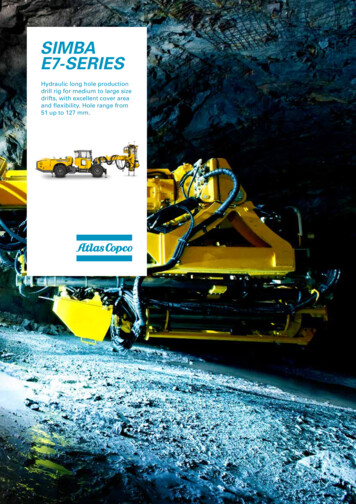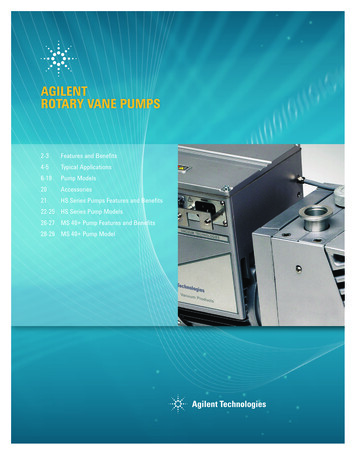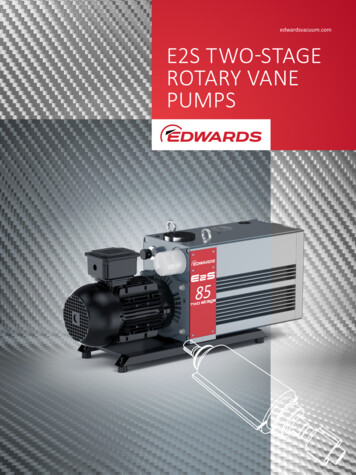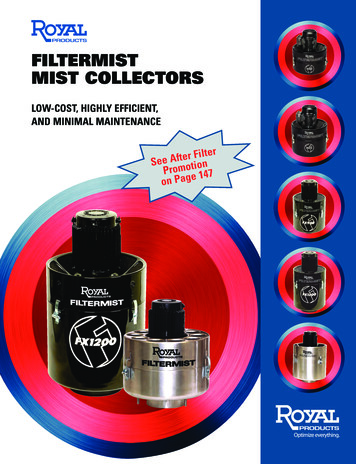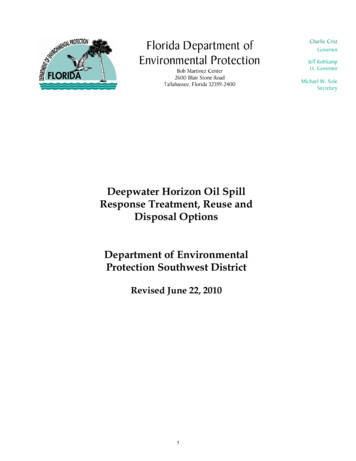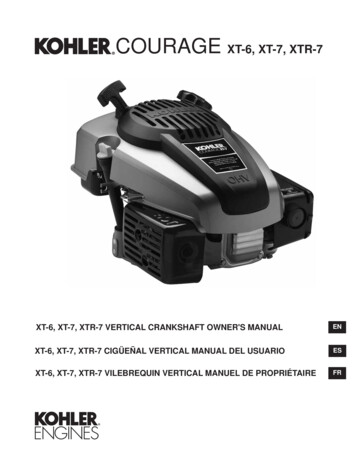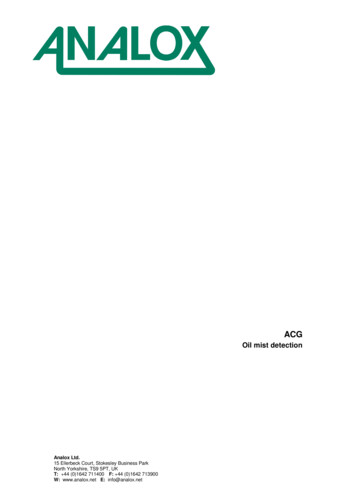
Transcription
ACGOil mist detectionAnalox Ltd.15 Ellerbeck Court, Stokesley Business ParkNorth Yorkshire, TS9 5PT, UKT: 44 (0)1642 711400 F: 44 (0)1642 713900W: www.analox.net E: info@analox.net
ACGOil mist detectionList of Contents1.2.3.4.Oil mist detection .2What is mineral and synthetic oil? .2How is oil mist generated?.2Why does oil mist appear in the output of a compressor?.34.1.Poor maintenance practices on the compressor filters. .34.2.High compressor output temperatures.34.3.Failure of seals. .45.How does the ACG sense oil mist? .45.1.Volatile organic compounds (VOC) detection. .45.2.Carbon monoxide (CO) detection. .55.3.Water detection. .56.Q&A.57.Acknowledgments .6Document Ref: RM-013-00 - January 2012Page 1
ACGOil mist detection1.Oil mist detectionThe presence of oil mist in compressed breathing air is a significant problem. Inhalation ofeither mineral and synthetic oil mist can cause respiratory irritation, dizziness, nausea andeven unconsciousness. The presence of oil mist also results in the pipes of a compressed airsystem being coated with oil. This increases the risk of fire, particularly if used with enrichedoxygen, and can be difficult and costly to clean up afterwards.With the advent of synthetic oils the detection of oil mist has become more difficult. This isironically due to some of the benefits of using synthetic oils in the first place. Their greaterstability means that much higher temperatures are required to cause evaporation, meaningthat oil vapour detectors are less effective at detecting the presence of oil mist. Their higheroperating temperatures also mean that combustion is less likely and hence the presence ofcombustion products such as carbon monoxide is less likely too.This paper outlines Analox’s approach to the detection of oil mist and lubrication issues in thecompressor.2.What is mineral and synthetic oil?Mineral oil is essentially a natural product derived from crude oil. Produced as part of thedistillation of crude oil, it comprises a mixture of numerous light oil fractions (typically in therange C15 to C50, alkanes and cyclo-alkanes).Synthetic oil is a synthesized product made from methane, carbon monoxide and carbondioxide. By controlling the quality of the feedstocks and the synthesis process, the oilproduced is much more uniform in composition (commonly poly-alpha-olefins or esters) andhas fewer impurities than mineral oils. The key benefits are greater resistance to oxidisationand thermal breakdown, longer service life, and better chemical and shear stability.3.How is oil mist generated?The following diagram shows the typical elements that make up a breathing air compressorsystem and the flow of gas through it.Figure 1 - A typical air compressor system.All compressors require lubrication to minimise frictional heating and wear of their movingparts, the majority are oil lubricated. During normal operation, movement of a compressorsinternal parts leads to the deposition of a thin oil residue on all surfaces of the compressionchamber. The high speed of motion and the great forces required to compress the air, resultin some of the oil being atomised. As a result all compressed gas at the output of thecompression chamber will contain some oil mist.Document Ref: RM-013-00 - January 2012Page 2
ACGOil mist detectionUnder normal conditions this oil mist is then removed by the after cooler and filters on theoutput of the compressor, typically a mixture of coalescing and charcoal filters.Other sources of oil mist can be as the result of filter carry over. Under certain faultconditions the oil collected by a filter is re-atomised back into the air flow.In the respect of oil mist creation, both synthetic and mineral oils behave in much the sameway.4.Why does oil mist appear in the output of a compressor?A properly maintained compressor should never generate oil mist above statutory levels in itsfiltered output.There are however a number of mechanisms that can cause oil mist to appear in the output ofa compressor:4.1. Poor maintenance practices on the compressor filters.If filters are not replaced or maintained in a timely manner, they can fail to remove theoil mist from the gas flow or even become a source of oil mist in their own right. In thecase of coalescing filters they can re-entrain oil mist if the gas flow is prone to suddenhigh flow pulses or if they become flooded because the drain mechanism fails.Particulate or charcoal filters can fail by becoming exhausted and effectively saturatedwith oil or by being partially blocked, leading to higher than expected flows that can reentrain oil from the filter media. These situations will result in oil mist being carried overinto the compressor output.If the filter media is not fitted correctly such that gas can bypass the media or the gaspath is much less torturous than intended, oil mist carry over can also occur.4.2. High compressor output temperatures.The output of a compressor’s compression chamber will always contain a quantity of oilmist. The quantity of this contamination is dictated by the temperature in thecompression chamber and the volatility of the oil used. Under normal operatingconditions the temperature of the gas leaving the compression chamber is well belowthe flash point of the oil so the quantity of contamination will be low. The filtration onthe output will be designed to remove this level of contamination so the quantity of oilcontamination is controlled.If the discharge temperature of the compressor rises, more oil mist will be present atthe compression chamber output. If the temperature rises significantly, the oil willbreak down and significant quantities of contaminants will be produced. Any increaseof contamination will have the effect of consuming the filters at a higher rate thanexpected and result in their early failure. Oil mist can be carried over these exhaustedfilters.There can be many causes of increased discharge temperature at the compressionchamber: Lack of cooling, potentially cased by low air flow over cooling vanes, or failure ofthe cooling system.Overloading the compressor, by running the compressor outside its specifiedoperating limits. For example by running the compressor for longer or at a higheroutput pressure than it was designed for.Running the compressor in an environment where the ambient temperature ishigher than it was designed for.Document Ref: RM-013-00 - January 2012Page 3
ACGOil mist detection Insufficient oil delivered to the moving parts of the compressor will result ingreater friction and higher operating temperatures.A build-up of carbon residues on valve seats, which results in a reduction inefficiency of the compressor and consequently an increase in the loading andoperating temperature of the compressor. Carbon residues can also create hotspots in the compression chamber that can ignite oil vapour if the flash point isexceeded.In extreme cases the temperature of the gas leaving the compressor can be so highthat it will melt the casings of filter elements or even worse cause the oil that has beencollected by the filters to burn. This produces large volumes of contaminants.4.3. Failure of seals.The seals on many of the working parts of a compressor are critical in separating bothbulk quantities of lubricating fluids from the compressed gas and unfiltered and filteredflows of compressed gas.If a seal fails in the compressor and bulk oil is introduced into the gas flow, the filterswill quickly be overwhelmed and oil mist will be introduced into the compressor output.If seals fail on filter elements, such that unfiltered gas can bypass the filter it will thenbe possible for any oil mist in the gas to pass straight to the compressor output.One key factor to bear in mind with all three of the failure mechanisms listed above, isthat other contaminants will also be generated or present at the output as a result ofthese failures.5.How does the ACG sense oil mist?The ACG has a sample support function for sampling the compressors output directly. Thisallows the use of industry standard colourmetric sampling tubes. These tubes operate byreacting chemically with the oil present in the sample and either display the concentrationagainst a scale on the tube or change colour to indicate the presence of a specified quantityof contamination.The same sample support function can also be used with a device such as the DraegerImpactor. This operates by a different principle to the tubes, in that the impactor collects asample of the oil mist in the gas flow on a plate and by a novel optical method provides aquantitative display of the amount of oil mist present.Use of the sample support function is a one shot detection method and does not give onlineprotection at all times when the compressor is in use. In order to give an online warning ofpossible oil mist contamination, the ACG employs a number of other sensors that measurecontaminants that are also typically found when oil mist is produced by a compressor. Whenone or more of these contaminants are detected and the source is not readily identified, it isrecommended to also carry out an oil mist check with a tube or impactor. The sensors usedto give a warning of oil mist are:5.1. Volatile organic compounds (VOC) detection.VOC’s are a natural constituent of mineral oils and produce a greater concentration ofVOCs at a given temperature than synthetic oils. The principle however remains; if oilmist is present, VOCs are present, any increase in oil mist concentration will have acorresponding increase in VOC concentration.During fault conditions as described above, increased discharge temperatures from acompressor will result in increased oil mist generation. This will also result in anincreased level of VOC’s. The VOC sensor used in the ACG is high energy PID deviceDocument Ref: RM-013-00 - January 2012Page 4
ACGOil mist detection(10.6eV) and has been selected to detect as wide range of the VOCs as possible.When using Mineral oils the VOC sensor is a reliable method of detecting the presenceof oil mist. When using synthetic oils, the VOC sensor can be an indicator that a failurehas occurred in the compressor and oil mist may be present.5.2. Carbon monoxide (CO) detection.As described above, increased output temperatures from a compressor can result inincreased oil mist generation. Increased compressor temperatures can also cause thepartial combustion of the oil which will produce elevated levels of CO.It should be noted that CO contamination can also result from other sources such asvehicle exhausts near to the air compressor inlet. As such the presence of CO shouldonly be treated as a possible indicator of oil mist contamination.5.3. Water detection.As water vapour is usually a constituent of the inlet gases, it is generally the watercontent that causes the desiccant filters to become exhausted first. It is therefore agood indicator that filters are overdue replacement or service.Elevated levels of water can also indicate that there is a potential problem with theoperating temperatures of the compressor or that the seals are beginning to fail.Where discharge temperatures are increased the ability of the after cooler to removethe water content is compromised, this will result in the filters after it being consumedmore quickly. In the case of seal failure, contaminated gas can bypass the filters.Once again these fault conditions can also result in greater oil mist contamination, sothe increase in water content should be used as an indicator that an oil mist test shouldbe carried out.6.Q&ASo can I use the ACG as a monitor on my compressor which uses synthetic oil?Yes, as many of the mechanisms that generate oil mist also generate other contaminantssuch as VOC’s, CO and water vapour. The online sensors for these contaminants can givean indication that problems may be present with the compressor, that are resulting in thegeneration of oil mist. These indications can be used as a prompt to perform an oil mist testusing the sample support feature.It should be noted that the use of the ACG is not a substitute for regular preventativecompressor and filter maintenance. The first line of defence against oil mist is ensuring thatthe compressor and filters are operating correctly!How often would you suggest I take an oil mist sample at the ACG’s sample supportport?The frequency of routine sample testing depends upon the level of usage of the compressor,how close to the design limits it is used and the scale of impact that contaminated gas wouldhave on the compressed air system to which it is attached to. As a minimum we wouldrecommend performing an oil mist sample test at least once every three months, to coincidewith the calibration checks of the other sensors in the ACG.Another good practice is to perform an oil mist sample test when the water, CO or VOCsensors alarm as they may be indicating a compressor problem, particularly if the source ofthe alarming contaminant is not obvious.I have several compressors which use different types of mineral and synthetic oils – isthe ACG suitable for use with all of them?Yes, the ACG works with all types of breathing air compressor.Document Ref: RM-013-00 - January 2012Page 5
ACGOil mist detection7.AcknowledgmentsAnalox would like to thank the following people for their help in the preparation of this paper:Andrew Chalmers - Filter Integrity LtdAndrew Porter - Bauer UKDerek Holmes - Compressor ConsultantDocument Ref: RM-013-00 - January 2012Page 6
Oil mist detection Document Ref : RM-013-00 - January 2012 Page 5 (10.6eV) and has been selected to detect as wide range of the VOCs as possible. When using Mineral oils the VOC sensor is a reliable method of detecting the presence of oil mist. When using synthetic oils, the VOC sensor can be an indicator that a failure
